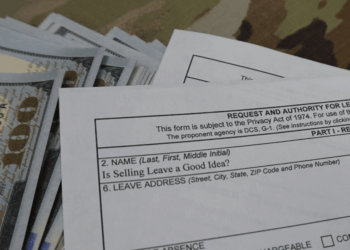When Heather Walrath’s husband retired from the Air Force in January, she knew they should consider the Survivor Benefit Plan (SBP).
After all, she’s a financial educator and a military benefits liaison with Navy Mutual. The SBP, which allows a portion of a service member’s retirement pay to continue when they die, is typically only available at the time of retirement.
However, there is a a rare Open Enrollment Season occurring for 2023 that allows a second look at previous decisions.
The Survivor Benefit Plan is available to military retirees and allows them to preserve a portion of their income for their survivors after they pass away. The catch? Retirees must opt in by midnight on the night before they retire, and once they are opted in, there are few options to opt out. This year, though, retirees who did not opt in to SBP at the time of retirement are able to enroll in the program, and those who enrolled at retirement but would like to opt out are also able to do so. This is the first time retirees have had this ability for the past 17 years.
Consider only your circumstances
It’s a mistake to base your SBP decision on what someone else did, Walrath cautioned. Individuals instead need to determine a value for their potential SBP and explore how it might compare to – or complement – a life insurance plan, retirement savings and a spouse’s pension.
Walrath urged service members to answer the following questions when making a decision about their SBP election.
About opting in to SBP:
- What are my survivor’s/survivors’ income requirements?
- How will I meet those income needs?
- Do I have a child who is incapable of self-support and would he or she benefit from a life-long benefit?
- What would be the value of my SBP benefit?
- How much will it cost?
- Am I willing to pay into SBP retroactively, including a small interest charge, if I retired before 2023 and didn’t opt in to SBP at the time?
About discontinuing SBP:
- Have my survivor’s/survivors’ income needs changed?
- Have I established other income sources to meet those needs?
- Is that income from inflation-protected sources?
- Am I willing to forfeit my payments so far? They will not be returned.
- Does my beneficiary agree to discontinue the benefit? Notarized consent may be required.
You decide the “elected amount” for your SBP up to the amount of your full retirement pay. The price is 6.5% of your elected amount if your beneficiary is a spouse. It’s lower if your beneficiary is “child only.” A qualifying child is up to age 18 (or 22 if in school), or one of any age who is incapable of self-support.
“A typical child-only premium is usually less than $20 depending on the amount elected and the age of the qualifying child at retirement,” Walrath said.
Adding your child as a beneficiary along with your spouse increases your premium by only a few cents per month. It’s also important to know the elected amount isn’t the amount your survivor would receive.
“The benefit is always going to be 55% of the elected amount,” Walrath said. “So even if you select your full retirement pay, the SBP benefit is still 55%.”
You pay premiums for 30 years and until you’re 70 – or until you no longer have an eligible beneficiary. The premums paid are not taxable. However the benefit is taxed. Cost of living increases are added to the benefit based on inflation.
“Every year that Congress authorizes retirees to get a pay increase,” Walrath said, “it also applies to all the survivors.”
She finds that some military retirees are comforted to know their survivors can have an inflation-protected income.
Talk to an expert
Walrath detailed the intricacies of SBP as easily as counting to 10. There are many nuances to the SBP program and understanding the costs and benefits can be daunting. Unfortunately, there is a lot of misinformation about the program circulating in various media.
“There’s so much confusion out there,” she said with concern.
Scrolling through social media, Walrath said she cringes when she sees “survivor’s benefit plan.”
“I’ll look at the posts and say, ‘That’s wrong, and that’s wrong, and that’s wrong’,” said Walrath, who is an accredited financial counselor with more than 14 years’ experience within the Department of Defense.
If a retiree or retiree-to-be is thinking about opting in to SBP, they should consult with an installation financial counselor or a financial planner who truly understands the potential value of military benefits, Walrath said.
“Talk with someone who can see the big picture for you,” she said. “I caution people to make sure that they’re talking to someone who truly understands the Survivor Benefit Plan and any other benefits that they might be entitled to.”
Walrath and her co-workers at Navy Mutual are also available to assist all service members, regardless of their branch.
“We work with everybody, and everything’s completely free,” she said. “We have a whole education of veteran services side at Navy Mutual. We’re the oldest federally recognized VSO, veteran’s service organization. You don’t have to be a member or have a policy.”









































